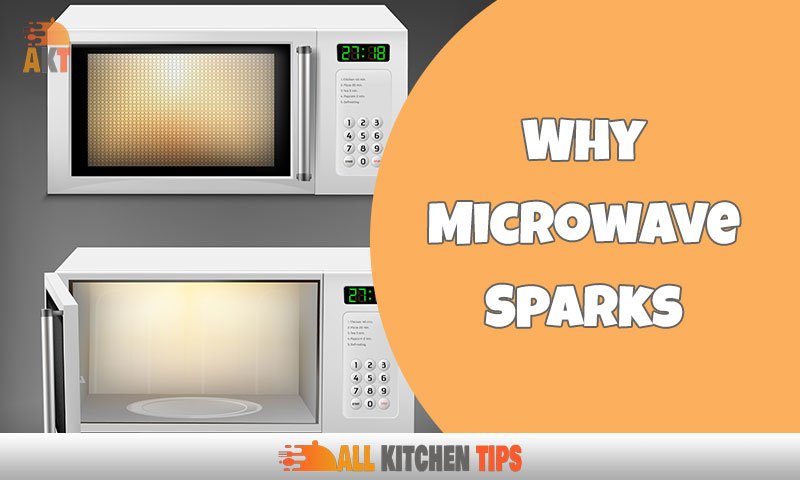Have you ever been in the middle of heating something up in the microwave, only to suddenly see sparks fly? It can be alarming, but luckily, it’s not usually anything major. There are several common causes of sparky microwaves. Let’s investigate together why your microwave may be sparking and what you can do to prevent it.
Oftentimes, it’s nothing more than food or a container interfering with the microwaves themselves. When a charge builds up due to the food being close to the high voltage capacitor, sparks will fly out as a natural reaction. We’ll talk about this in more detail later, but know that simply rearranging your food should usually solve the problem.
So, if your microwave is sparking but still seems to work, don’t panic just yet—this article should help you figure out what’s going on and how to stop it from happening again. Read on for more information on common causes of sparks in microwaves and advice on fixing them safely.
What Causes Microwave Sparks
Have you ever opened the door to your microwave and seen sparks flying? If so, you may have been wondering what causes these sparks. The answer is that sparks occur due to a build-up of charged particles that are then released in a powerful surge.
The presence of metal objects in the microwave can cause electrons to move around and form an arc of electricity, producing both sparks and heat. Additionally, grease and food particles that accumulate on the waveguide cover can also cause sparks. This essentially happens when the waves hit the particles, resulting in an electrical charge that jumps either to the walls or roof of your oven, resulting in a spark being created.
So if you’re noticing sparks when microwaving your food, it’s time to do some investigation into where they’recoming from. Remember, never to put any metallic objects or aluminum foil in your microwave, as this will further lead to additional sparking.
Understanding How a Microwave Functions
Have you ever opened your microwave to discover sparks inside? As it turns out, this can be a common occurrence. The reason behind the sparks lies in how a microwave actually works.
Inside the oven, there’s a device called a magnetron that produces microwaves. These microwaves channel heat energy directly to the molecules inside food. Microwaves are generated by the magnetron and passed through food to create friction between particles, thus producing heat and cooking the food.
The sparks you might see result from food particles that don’t get completely cooked or heated due to their placement in the oven, like pieces on the outer edges of a rotating plate. Sparks won’t harm you, but they could damage components in your microwave if they happen too often or with enough intensity, so it’s good to keep an eye on it.
Properly Closing the Door of the Microwave
A third reason why you’re seeing sparks in your microwave might be that the door itself isn’t closing properly. This could be due to a number of different issues.
Door Latch Assembly
The door latch assembly is responsible for keeping the door shut when the microwave is in operation. If this latch is broken or damaged, it can create gaps that allow air to penetrate the cavity, and cause sparking. It’s important to check for the proper alignment and contact of the latch.
Torsion Springs
The torsion springs hold tension on the door, preventing it from popping open during regular use. Broken or loose torsion springs can weaken the connection between door and frame and cause gaps as well. If you notice that your torsion springs are bent or broken, replace them as soon as possible so that they can ensure a good seal.
Obstructions & Damaged Latch
Another frequent cause of sparks in the microwave is obstructions between the door and frame or a damaged latch preventing it from closing properly. Be sure to take time to inspect your microwave, check for any obstructions between the door and frame, and make sure your latch is not damaged before turning it on again.
Old Food or Metal Trays Can Cause Sparks
Have you ever opened your microwave after cooking something and noticed sparks inside? Well, you’re not the only one. Sparks in the microwave can be caused by a few things.
Metal Trays
If you have a metal tray in there, then this could be the culprit of your sparkly show. That’s because metal trays inside the cooking cavity can cause induction of voltage and current-producing sparks when current passes through them.
Metal Fragments or Damaged Waveguide Cover
Another possible cause of sparks is when small pieces of food containing metal get stuck around the waveguide cover. Or maybe there’s an issue with the waveguide cover itself—like if it’s broken or detached from its spot, allowing microwaves to escape and potentially catch on metal items in your kitchen.
Arc Discharging Sparks
Lastly, arcing occurs when metal sparks in the microwave due to an electric current passing through air particles between two combs within the oven cavity, causing so much electricity that it eventually gives off a spark. This can happen if something is too close to either wall and is blocking microwaves from bouncing around properly, or due to microwave leakage caused by worn seals and gaskets within the cavity walls.
Clean Your Microwave and Replace Your Filter
Sometimes, sparks can be caused by a dirty filter. It’s important to clean them regularly, but you also need to replace them at least every six months so that they can do their job properly.
The most common filter is a grease filter, and it’s usually located underneath the microwave. To clean it, all you’ll need is some hot water and liquid soap. Gently scrub away any excess grease or food particles with a sponge, then rinse with cool water and let it dry before putting it back in place.
It’s also important to check your charcoal filter if you have one – this should be replaced every six months to keep your microwave running optimally. If you don’t have one already installed, take a moment to look up how to fit one in your model of microwave.
When to Contact Service Professionals
Sometimes a DIY approach isn’t enough, and you need professional help. If that’s the case, you may be wondering, “When should I call for microwave repair?”
Signs that it may be time to contact a service professional for repairs include:
- Food is not cooking properly.
- Door not sealing properly.
- Strange sounds coming from the appliance.
- Sparks or smoke shooting out of it.
When manufacturers produce microwaves, they typically offer a one-year warranty on the product. Depending on the extent of your microwave’s damage and the parts needed to repair it, the average cost of repair is around $175. So if you’re concerned about costs, it might make sense to check if your microwave is still under warranty before getting in touch with a service professional.
People Also Like: Learn How to Clean Indoor Grill to Keep Shiny and Spotless
Conclusion
Judging by all that we’ve discussed, you’ve probably realized that sparks in the microwave are nothing to worry too much about. A few sparks here and there are completely normal, but if you continue to experience sparks that are too frequent, it could be a sign that something is wrong.
It’s always best to have your microwave checked by a professional. If the sparks stem from malfunctioning components, it’s much better to have them fixed as soon as possible. Otherwise, you’ll just be creating more and more sparks, which can be dangerous.
The sparks that come from your microwave are harmless for the most part, but it’s always better to be safe than sorry. If you find that you’re constantly seeing sparks, then it might be time to take a deeper look into the source of the problem.





